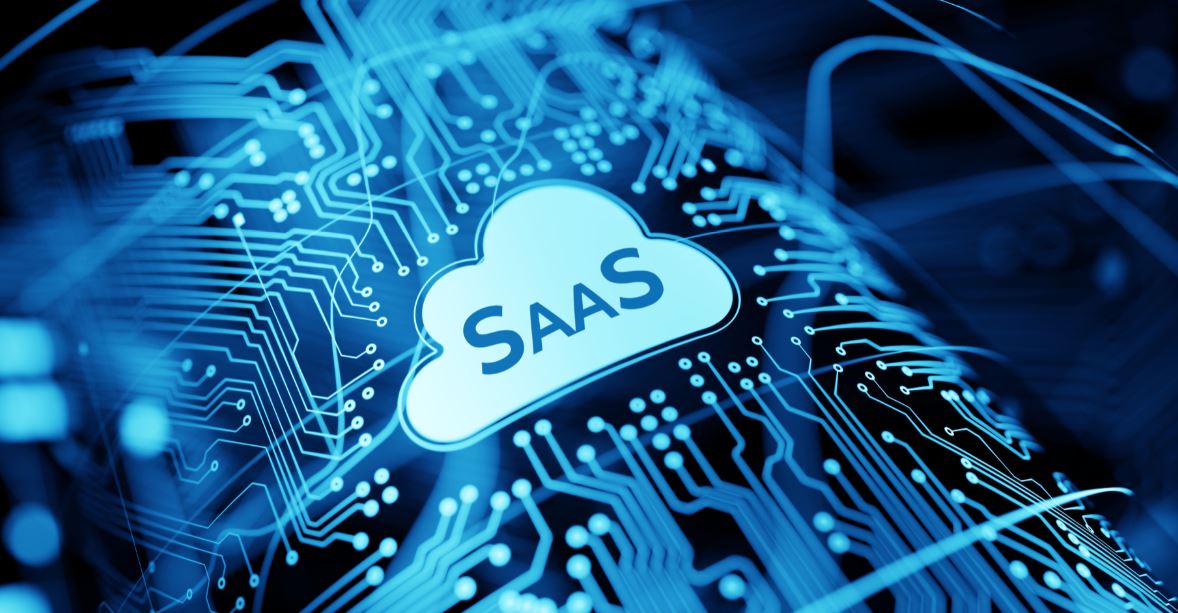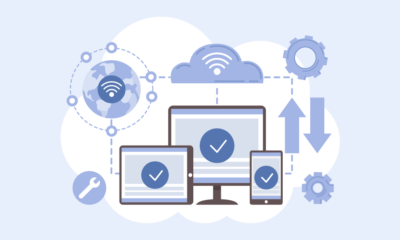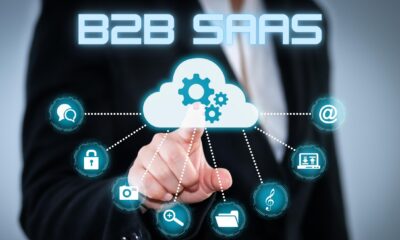Tech
SaaS: Business in the Digital Age

Introduction
The business operations landscape has been profoundly transformed by the revolutionary power of Software as a Service (SaaS). This innovative approach offers scalable and cost-effective solutions that significantly enhance efficiency and productivity. By delivering software applications over the internet, SaaS has revolutionized the traditional model of on-premises software installs, introducing a level of flexibility and accessibility that was previously unheard of.
Understanding SaaS
Software as a Service (SaaS) is a user-friendly software providing system in which users can get applications via the internet hosted by a service provider. This model is a flexible option for companies of all sizes since it enables customers to access Software from any device with an internet connection.
Benefits of SaaS
The SaaS model’s broad popularity can be attributed to its many advantages.
Cost Efficiency
One of the most compelling advantages of SaaS is its cost efficiency. Companies can significantly decrease their upfront costs for Software and hardware by opting for a manageable membership fee instead. This predictable cost structure allows for better financial planning and control, instilling confidence in the investment.
Scalability and Flexibility
Because SaaS systems are so scalable, companies may modify their usage in response to demand. Scalability in SaaS refers to the system’s ability to handle an increasing workload by adding resources, and conversely, to reduce the resources when the workload decreases. This means that as your business grows, the SaaS system can adapt and handle the increased demand without the need for significant infrastructure investments.

SaaS
Key Features of SaaS Solutions
SaaS applications come with several crucial features that enhance their usability and effectiveness.
Updates Automatically
SaaS providers handle the upkeep of Software and upgrades, so customers don’t have to worry about keeping up with the changes. This means that your Software is always up-to-date with the newest features and security improvements, ensuring that your operations are not disrupted and your data is secure.
Collaboration and Accessibility
Because SaaS programs are accessible online, they make distant work and collaboration easier. Access to the same data and resources from different places allows team members to collaborate and work more efficiently—Integration Capabilities.
Integration with other Software and services is a feature of many SaaS solutions. SaaS applications can seamlessly integrate with different tools and systems, such as CRM software, email marketing platforms, or project management tools. This enables companies to build an integrated technology ecosystem where this compatibility improves data management and workflow efficiency.
SaaS in Different Industries
SaaS solutions have been adopted across various industries, benefiting from the model’s unique advantages.
SaaS in Healthcare
SaaS applications are utilized in the healthcare sector for patient management systems, telemedicine, and electronic health records (EHRs). These technologies strengthen data security, expedite administrative duties, and improve patient care.
Advantages for Medical Professionals
Healthcare SaaS solutions enable providers to access patient data from any location, improving care coordination and continuity. Furthermore, automatic updates guarantee adherence to the most recent rules and specifications.
SaaS for TeachingEducational institutions use SaaS for administrative management, virtual classrooms, and learning management systems (LMS). These resources facilitate distance education, improve student involvement, and streamline administrative procedures.
Advancing the Educational Process
SaaS solutions in education enable dynamic and customized possibilities for learning by giving teachers and students access to many tools and resources. Cloud-based solutions also make it easier for professors and students to collaborate.
Streamlining Management of SaaS
SaaS solutions make administrative duties like scheduling, grading, and enrolment easier for educational institutions. Due to this simplification, teachers can concentrate more on instruction and less on administrative work.
Upcoming Trends in SaaS
The SaaS market is dynamic and evolving, with emerging trends shaping the industry’s future. From merging AI and machine learning to enhancing security protocols, these developments are set to revolutionize the capabilities and applications of SaaS further.
Integration of Machine Learning and AI in SaaS
The capabilities of SaaS applications are being improved by using artificial intelligence (AI) and machine learning. SaaS solutions gain tremendous value from these technologies, enabling sophisticated data analysis, tailored user experiences, and predictive insights.
Customized User Interfaces
AI-powered SaaS apps can deliver individualized experiences by analyzing user behavior and preferences. This customization increases the user’s engagement and contentment.
Improved Security Protocols
SaaS providers invest in cutting-edge security measures to safeguard customer data as cyber threats become more complex. Regular security audits, multi-factor authentication, and encryption are becoming standard procedures.
Data Compliance and Protection
Improved security protocols guarantee that SaaS apps abide by data protection laws like GDPR and HIPAA. Compliance is essential for sectors like healthcare and banking that deal with sensitive data.
Summary
Thanks to its ability to provide scalable, adaptable, and reasonably priced software solutions, SaaS has completely changed how businesses run. Its advantages, including accessibility, integration possibilities, and automatic updates, make it a valuable tool for various sectors. SaaS will probably include AI and improved security features as technology develops, reaffirming its position as a vital component of contemporary corporate operations.
Tech
Is It the Right Time to Start PPC? 5 Expert Tips to Guide You

Pay-per-click advertising can be a great avenue for any business to drive targeted traffic and upscale conversions. It can easily become time-consuming with fewer results than expected if the timing is wrong. Understanding when to start your PPC campaigns can help you attain a better ROI. The following are five tips that will tell you when the right time is to create and launch your perfect pay-per-click campaign.
-
Assess Your Business Goals
Before running a PPC campaign, make sure that your business objectives align with the possible outcomes of the campaign. PPC is most effective when applied to achieve definite goals: website traffic increase, generating leads, and driving sales. If your goals are not clear or defined vaguely, it’s better to refine them before investing in paid ads. Take the time to assess your readiness, including factors such as clarity of target audience, market demand, and your ability to measure campaign performance. A clear alignment between your goals and PPC’s capabilities ensures that you are not jumping in prematurely.
-
Establish a Solid Digital Foundation
Your PPC campaigns are only as strong as your digital infrastructure. Before you begin, make sure your website is optimised for UX: it loads fast, the navigation is clear, and the landing pages are compelling. Also, set up the essential analytics tools that will help you track the performance of your campaign as accurately as possible. Without a solid foundation, even a brilliant PPC strategy might fail to bring in the expected results. Investing in these preparatory steps helps you maximise the effectiveness of your PPC campaigns when you’re ready to launch.
-
Customise Your Approach with Tailored Solutions
Success in running a pay-per-click strategy often depends on just how well your campaigns match up to meet the needs of your particular business. Instead of a one-size-fits-all approach, invest in PPC packages that are customised to your specific goals and audience. By tailoring strategies, targeting is much more exact, ad placement will be better, and it keeps focused on metrics important to your business. Whether it’s picking the correct keywords, crafting personalised ad creatives, or setting the right budget, customised solutions afford the flexibility and control required for effective campaigns.
-
Monitor Your Competition and Market Trends
With PPC, timing is everything, and an important factor is competition. It’s in researching competitor activity and industry trends that one may find valuable insights into market timing. As an example, if your competitors heavily launch their campaigns during peak seasons, this could be the appropriate time to start yours as well, or it could also mean finding a quieter time wherein your ads have better chances of getting views. Keeping yourself updated on market trends will guarantee that you maximise your best opportunities in implementing PPC.
-
Ensure Your Budget is Ready
PPC campaigns require a financial commitment, so it’s crucial to allocate a budget that aligns with your goals. Evaluate your business’s financial position to determine if you can sustain an ongoing PPC strategy without compromising other operational needs. Starting small and scaling up as you see results is a smart approach. Additionally, plan for contingencies such as testing multiple campaigns or reallocating funds to higher-performing strategies. A well-planned budget ensures you don’t overspend and simultaneously optimise your PPC efforts.
In conclusion, PPC advertising has the potential to be a game-changer for businesses ready to take their online visibility to the next level and drive meaningful results. However, starting at the right time with a clear strategy is key to making its potential a reality. Remember that successful PPC is not just about when you start – it’s also about how prepared you are to sustain and scale your efforts.
Tech
Boosting Performance with Nitro Fuel: Tips for RC Enthusiasts

For RC enthusiasts who crave speed, power, and the thrill of a roaring engine, nitro fuel remains a top choice. Unlike electric motors, nitro-powered RC vehicles provide a unique experience, with real combustion engines that replicate the excitement of full-sized cars. However, to truly get the best performance from nitro fuel, it’s essential to understand the intricacies of fueling, tuning, and maintenance. Here’s a complete guide on how to maximize performance with nitro fuel in your RC vehicle.
What is Nitro Fuel?
Nitro fuel, also called glow fuel, is a specially formulated blend used to power RC cars, planes, and boats with combustion engines. It typically contains:
- Methanol: The primary fuel component.
- Nitromethane: Boosts combustion and adds power.
- Lubricants (usually castor or synthetic oil): Keeps the engine lubricated during operation.
The nitromethane percentage in the fuel determines the power output; higher percentages yield more power but can increase wear on the engine. Common blends range from 10% to 30%, with RC cars typically using between 20% and 30% for optimal performance.
Tips for Boosting Nitro RC Performance
With a few key practices, you can maximize both the speed and longevity of your nitro-powered RC vehicle.
1. Choose the Right Nitro Blend
Selecting the right nitro fuel blend is crucial. Beginners might start with lower nitromethane percentages (10-20%), as they are less demanding on the engine. However, advanced users who want high performance typically go for a blend between 20-30% nitromethane. Higher nitro content delivers more power but will also make the engine run hotter, so be prepared for potential adjustments in tuning and maintenance.
2. Keep Your Engine Tuned for Optimal Performance
Tuning is vital for maximizing nitro fuel performance. A well-tuned engine ensures fuel is burned efficiently, giving your RC vehicle the power and responsiveness you need. The two key tuning adjustments are:
- High-Speed Needle (HSN): Controls fuel flow at high speeds. Adjusting the HSN impacts top speed and overall fuel efficiency.
- Low-Speed Needle (LSN): Manages fuel flow at low speeds, affecting acceleration and idling.
To achieve an optimal tune, start by adjusting the HSN, finding a balance where the engine performs smoothly at full throttle without stalling. Then, fine-tune the LSN to ensure smooth acceleration from a standstill. For accurate adjustments, test the vehicle under various loads and conditions.
3. Use a Quality Glow Plug
The glow plug is essential to combustion in nitro RC engines, as it heats the fuel-air mixture for ignition. Performance can vary based on glow plug type:
- Hot Plugs: Best for low-nitro fuel blends (10-20%) and are used in colder weather conditions.
- Medium Plugs: Suitable for most applications and work well with medium nitro blends (20-25%).
- Cold Plugs: Best for high-nitro fuel (30% or higher) and warmer weather.
Regularly inspect and replace glow plugs, especially if you’re experiencing issues with inconsistent engine starts or decreased performance.
4. Maintain Proper Fuel Storage
Nitro fuel is sensitive to temperature and moisture, so proper storage is essential. Exposure to humidity can degrade the methanol, causing performance issues and potential engine damage. Here’s how to keep your nitro fuel in peak condition:
- Store in a Cool, Dry Place: Room temperature is ideal; avoid areas exposed to sunlight.
- Use Airtight Containers: Always seal containers tightly after each use to keep out moisture.
- Avoid Plastic Containers: Use fuel canisters designed for nitro fuel, as some plastics may break down over time.
5. Warm Up Your Engine Before Use
Cold starts can cause unnecessary wear on a nitro engine, as oil and fuel might not circulate properly. To warm up your engine, let it idle for about 30 seconds before pushing it to full throttle. This helps ensure that the engine reaches operating temperature gradually, reducing the risk of strain or damage to internal parts.
6. Run Your Engine at Optimal Temperatures
A nitro engine performs best within a specific temperature range, usually around 200–230°F (93–110°C). Running below or above this range can affect power output and engine life. If you’re pushing your vehicle to its limits, monitor the temperature with an infrared thermometer. If it starts to overheat, slightly enrich the fuel mixture by adjusting the HSN to avoid damaging the engine.
7. Regularly Clean the Air Filter
An RC car’s air filter ensures that only clean air enters the engine, preventing debris from causing damage or clogging. Keeping the air filter clean is essential for consistent performance. Depending on the environment (especially dusty or sandy areas), clean the filter frequently, and replace it if it becomes too worn or clogged.
To clean:
- Remove the Air Filter and gently wash it with a mild cleaner.
- Dry Completely before reinstalling.
- Lightly Oil with a special air filter oil to help trap dust and debris.
8. Practice Proper Engine Shutdown
Properly shutting down a nitro engine can help prevent damage and extend its life. When you’re finished running your vehicle, it’s best to avoid stopping the engine by simply pinching the fuel line, as this can lead to excessive fuel build-up in the carburetor. Instead, stop the engine by using a kill switch or an engine stop tool. After shutdown, consider adding a few drops of after-run oil to the engine to keep internal parts lubricated.
Troubleshooting Common Nitro Fuel Issues
Despite careful preparation, nitro engines may encounter common issues. Here’s how to address a few of them:
- Difficulty Starting: Check your glow plug, fuel lines, and carburetor settings. An old or damaged glow plug is often the culprit.
- Engine Overheating: Verify that your HSN is not set too lean, which causes excess heat. Adjust your tune or give the engine time to cool between runs.
- Loss of Power: This can occur if your air filter is clogged, the glow plug is worn, or your tuning is off. Start with a basic tune-up and ensure components are clean and functional.
The Experience of Nitro-Powered RC Vehicles
For many enthusiasts, the appeal of nitro-powered RC vehicles lies in the realism—the sound, smell, and thrill of a combustion engine. By following these tips for selecting, using, and maintaining nitro fuel, you can unlock maximum performance from your RC vehicle and enjoy an experience that’s both powerful and satisfying.
From proper tuning and fuel storage to selecting the best nitro blend, these tips will ensure your nitro-powered custom RC cars delivers peak performance every time you take it out on the track. Whether you’re a beginner or an experienced enthusiast, nitro fuel can provide the ultimate RC experience when used correctly.
Tech
VeriFace: Precision in Identity Authentication and Face Recognition

In the present computerized world, guaranteeing secure and exact character confirmation is more pivotal than ever. With the ascent of online administrations, organizations and people the same need dependable techniques to affirm personalities. This is where VeriFace becomes an integral factor, offering front-line face recognition innovation that upgrades identity verification processes. In this article, we will investigate how VeriFace uses progressed face verification methods to give exact and trustworthy character validation.
Understanding Face Recognition
At its center, face recognition is an innovation that recognizes or confirms an individual’s personality utilizing their facial elements. In contrast to customary techniques, for example, passwords or ID cards, face recognition uses exceptional natural qualities, making it a hearty answer for identity verification. By investigating facial examples, VeriFace can decide whether an individual’s face matches a put-away picture, giving an elevated degree of exactness and security.
The Importance of Identity Verification
As online exchanges and collaborations increment, so do the dangers of data fraud and misrepresentation. Identity verification is fundamental for safeguarding delicate data and guaranteeing that people are who they are guaranteed to be. Whether it’s getting to a ledger, signing into a solid help, or checking a client’s personality, organizations need dependable arrangements. VeriFace offers a cutting-edge way to deal with face verification, making it more straightforward for associations to safeguard themselves and their clients.
How VeriFace Functions
VeriFace utilizes progressed calculations to perform face recognition rapidly and precisely. The cycle starts when a client presents a photograph or sweeps their face utilizing a camera. The framework catches key facial highlights, for example, the distance between the eyes, the state of the facial structure, and the shapes of the cheeks. These elements make a one-of-a-kind facial mark, which VeriFace then, at that point, looks at against a data set of put-away pictures.
This correlation interaction is direct yet exceptionally compelling. In the event that the facial mark matches a picture in the data set, the framework affirms the singular’s character. This quick and effective technique for face verification upgrades security as well as further develops client experience by lessening the time required for confirmation.
Benefits of VeriFace
1. Upgraded Security
One of the essential advantages of VeriFace is its upgraded security highlights. By depending on face recognition, the framework limits the gamble of unapproved access. Not at all like passwords, which can be neglected or taken, facial highlights are remarkable and hard to reproduce. This biometric check technique guarantees that mainly approved people can get to delicate data.
2. Easy to understand Insight
VeriFace is planned in view of the client. The face verification process is fast and natural, requiring insignificant exertion from clients. With simply a look, people can verify their personality without the requirement for confounded passwords or extensive check processes. This effortlessness urges more clients to embrace biometric arrangements, at last prompting more prominent security.
3. Versatility
One more critical benefit of VeriFace is its versatility. Organizations, everything being equal, can execute this face recognition innovation to improve their safety efforts. Whether a little startup or a huge company, VeriFace can be custom-fitted to address explicit issues, making it a flexible answer for identity verification.
4. Diminished Misrepresentation
By executing VeriFace, associations can fundamentally diminish the gamble of misrepresentation. The precision of face recognition innovation forestalls wholesale fraud and unapproved access. This is especially significant in businesses like banking, medical services, and Internet businesses, where it is vital to safeguard delicate information.
Utilizations of VeriFace
VeriFace has a large number of utilizations across different areas. The following are a couple of models:
1. Monetary Administrations
In the financial area, identity verification is basic for forestalling extortion. VeriFace can smooth out the record opening interaction by rapidly checking a client’s personality through face recognition. This upgrades security as well as further develops consumer loyalty by lessening standby times.
2. Travel and Friendliness
Aircraft and lodgings can use VeriFace for consistent registrations. By coordinating face verification into their frameworks, voyagers can sidestep long queues and partake in a more productive encounter. This innovation can likewise upgrade security at air terminals by guaranteeing that travelers match their tickets.
3. Medical care
In medical services, identity verification is essential for safeguarding patient data. VeriFace can assist medical services suppliers with affirming the personalities of patients rapidly, guaranteeing that clinical records are secure and available just to approved staff.
The Eventual Fate of Face Recognition Technology
As innovation keeps on advancing, the future of face recognition looks encouraging. Advancements in man-made consciousness and AI will additionally upgrade the exactness and dependability of VeriFace. With progressing headways, we can expect much safer and more proficient techniques for identity verification before very long.
End
In our current reality where security is fundamental, VeriFace stands apart as a forerunner in identity verification through its imaginative utilization of face recognition innovation. By giving precise, quick, and easy-to-use arrangements, VeriFace assists organizations with safeguarding delicate data and improving client encounters. As we push ahead, embracing biometric confirmation techniques like VeriFace will be fundamental for shielding our characters in an undeniably computerized scene.
-

 News5 months ago
News5 months agoBrooke Tilli – Bio, Age, Relationships, Career, Net Worth, and Boyfriend
-

 Celebrity4 months ago
Celebrity4 months agoPedro Vaz Paulo: A Life of Redemption
-

 Celebrity4 months ago
Celebrity4 months agoBurak Deniz: The Turkish Heart-Throb
-

 Tech5 months ago
Tech5 months agoCloud Computing: Enabling IT Innovation
-

 News5 months ago
News5 months agoDefine a Offshore Accident Lawyer
-

 Tech4 months ago
Tech4 months agoSaaS Integration: Cloud-Based Software
-

 Business4 months ago
Business4 months agoJanitor AI: Future of Auto Maintenance
-

 News5 months ago
News5 months agoAI Deepfake Threaten to Global Elections. No One Can Stop Them.





